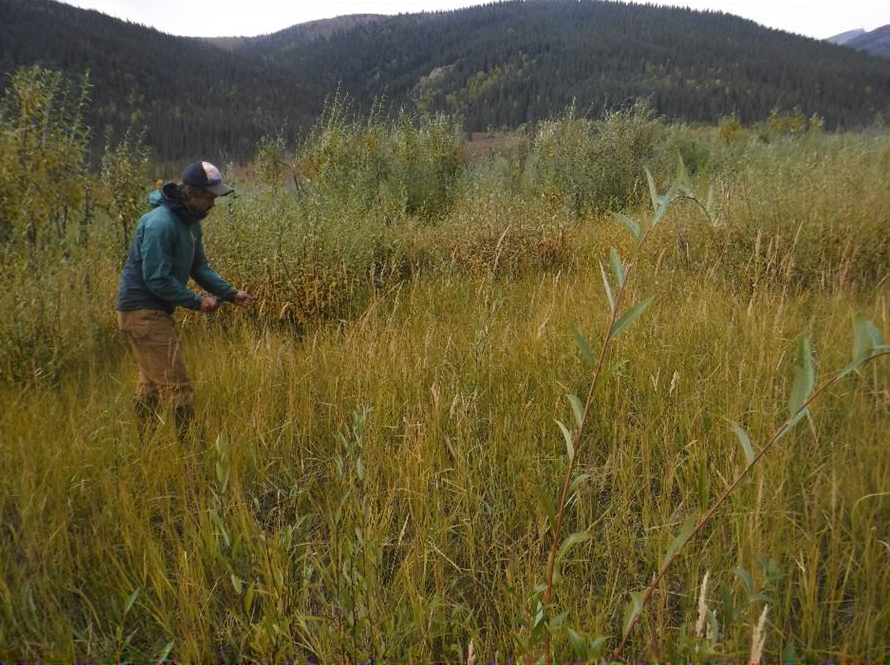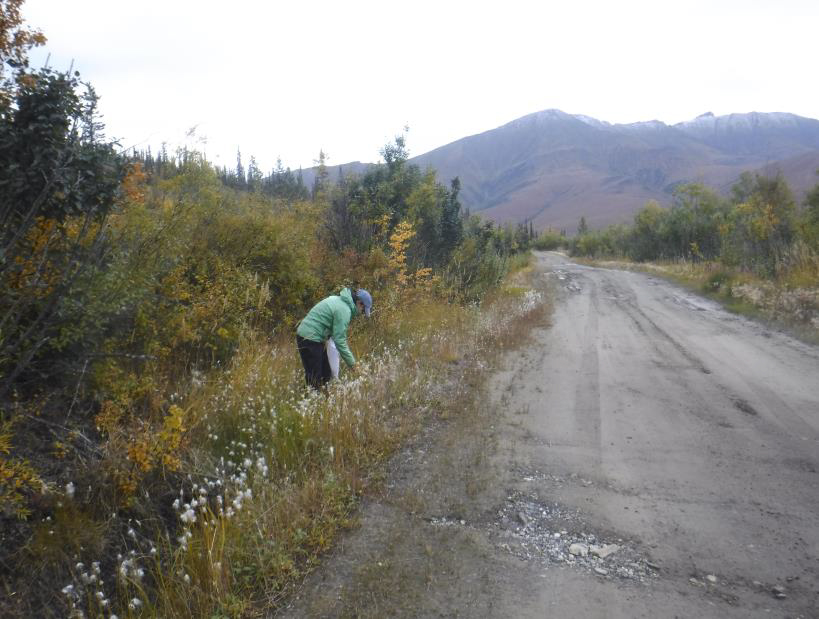You are viewing ARCHIVED content published online before January 20, 2025. Please note that this content is NOT UPDATED, and links may not work. Additionally, any previously issued diversity, equity, inclusion or gender-related guidance on this webpage should be considered rescinded. For current information, visit https://www.blm.gov/blog.
Alaska seeds for Alaska needs
He sees forbs and sedges where most would see broad-leaf and grassy, flowering weeds. Where most folks would see a field of ordinary looking grasses with scattered flowers, Eric Geisler sees reclamation success.
Geisler is BLM Alaska’s state program lead for Seeds of Success, and to him it’s all about the right seed growing into the right plant in the right location. Native plants are biological pillars that support an entire network of interdependencies. Scientists are just beginning to understand some of those relationships.
Seeds of Success is a national native seed collection program started in 2001 (2002 in Alaska). The BLM started the program in partnership with the Royal Botanic Gardens, Kew Millennium Seed Bank (MSB). Though the MSB has since dropped out, the program has grown to include many additional partners, including botanical gardens, cities, agencies, and various private organizations. There are two primary goals of the program — to preserve seeds in case of a massive die-off of a plant species and to gather enough seed for large-scale production. The production seed is used in native-seed mixes people can buy for use in their reclamation efforts and is grown by farmers.
The key to getting started is gathering large enough samples of the seeds you intend to grow. Seems simple enough, except it isn’t.

“Our expense of seed collection is going to the field,” Giesler explained. “We go to remote sites, which means to go there is a high cost. And if we go and the seeds aren’t ready to collect, that doubles the cost. So just trying to figure out what to collect, when to collect, and where to collect can be a real challenge.”
Variables like local weather conditions can move the harvest time by a week or more, and collecting in the rain can result in ruined seed. Geisler’s team tries to predict the best time to travel to the sites, but nature doesn’t always cooperate.

And the team isn’t exactly hauling back bushel baskets of grain. A successful harvest of a species might fill a bushel basket with seed pods, but the actual seeds might only cover the bottom of a sandwich bag.
“We’ve had collections that were only a few grams,” Geisler explained. “But we’ve got seeds that run maybe 4.5 million seeds to the pound – so 4.5 grams [.01 pound] is still 45,000 seeds. Larger seeds, like lupine, may be fewer than 10,300 per pound.”
The payoff comes from planting some of the relatively few gathered seeds and multiplying them by the millions, but there are important steps to accomplish first.
After the seeds are collected, they are taken to the state of Alaska’s Plant Material Center in Palmer where they are cleaned, dried, tested for viability, and stored. They also help with ‘seed increase’ by planting some of the gathered seeds in small box gardens and sometimes through commercial scale growing of difficult- (or expensive-) to-harvest seeds.
“Some species don’t lend themselves to commercial growing,” Geisler explained. “Some species’ seeds have an extended maturation time, where some seed is ripe in July, some in August, and the rest in September.”
For those kinds of plants, farmers use a seed stripper (like a broom with a vacuum) on multiple passes over a several week period. Because the harvest is in stages, and the plants can’t be cut for hay or other purposes in the meantime, the fuel, maintenance, and time costs are much higher than for a typical crop.
When a farmer agrees to plant for the program, the BLM will provide the ‘foundation seed’ to the farmer with the understanding the farmer will return the same amount of seed free of charge to the BLM. The BLM also has the first option to purchase as much seed as the farmer is willing to sell to the BLM.
BLM doesn’t always approach the farmer about producing native seeds, sometimes it’s reversed.
“We did have a grower who approached us offering to grow a particular forb,” Geisler smiled. “He’s been a grass grower for many years, and his daughter has determined she wants him to grow forbs, or as she terms them, ‘flowers.’ He asked for a specific species of sweetvetch [a native, perennial legume]. This summer we’ll see if the plant was successful.”
Geisler also said there are additional species they’re hoping to purchase from that farm.
Seed mixes from the program have been used in successful mine reclamation work. Giesler hopes future mixes will include more flowering species to add pollinator support. For the Alaska Seeds of Success program, Geisler tries to use Alaska growers exclusively. This helps to avoid the potential of introducing non-native plant seeds.
Right now, Geisler is having a hard time getting commercial quantities of Alaska-grown, Alaska-native forbs. Last year’s planting of the sweetvetch is the first, and the expectations aren’t high for this summer’s harvest.
“Growing seed for production is about a 5-year process,” Geisler explained. “Bringing a new field into production requires a lot of lead time for the BLM in collection, for the Plant Material Center to increase seed quantity [enough for production], and for the farmer in the planting and harvesting, production and cleaning, and getting the seed up to a sufficient quantity so that we can use it.”
So (or should we say ‘sow’) from the collectors, who are usually interns supervised by University of Alaska botanists, to the Alaska Department of Natural Resources and their Plant Materials Center and a number of Alaska growers, to the miners and various people trying to restore land to a more natural state, Alaska’s Seeds of Success program is very local. Alaskan seeds grown by Alaskans for Alaska.
To date, Seeds of Success in Alaska has 993 collections from 384 species. Geisler hopes this summer to increase the number of species, especially grasses from the North Slope.
Geisler recommends people consider native flowers when planting a garden. It’ll feed native pollinators and help reduce the chances of another invasive species taking hold.
State and federal agencies plan to expand forb growing operations to increase the number of species and quantity of seed available for revegetation projects. BLM Alaska, the Forest Service, National Resources Conservation Service, Fish and Wildlife Service, Alaska Department of Transportation, and the Plant Material Center are meeting this spring to make it happen.
James Hart, Public Affairs Specialist
Related Stories
Office
222 W 7th Avenue #13
Anchorage, AK 99513
United States
